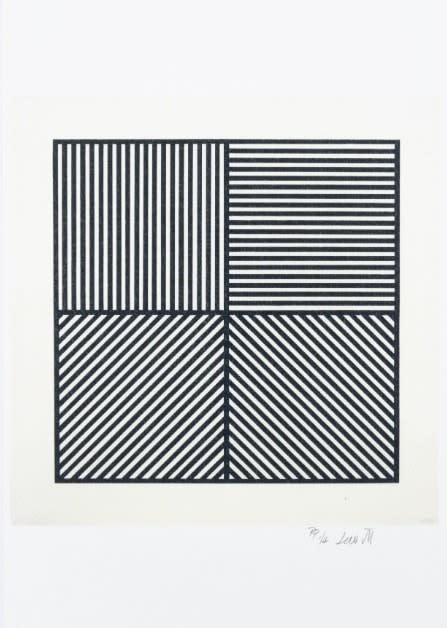Sol LeWitt
"The system is the work of art; the visual work of art is the proof of the system. The visual aspect can't be understood without understanding the system. It isn't what it looks like but what it is that is of basic importance."
LeWitt was linked to various movements, including conceptual art and minimalism, and was prolific in a wide range of media ranging from painting, drawing and printmaking to sculpture, wall murals and installation. The guiding principles of his work were line, geometry, ratios, patterns and formulas. Believing above all else that the artist is primarily a generator of ideas, his work was a vital stepping stone between the modern and postmodern eras.
LeWitt's work often assumed a basic physical form, though not always one produced by his own hands. Taking inspiration from the structure of a medieval workshop, in which the master conceives of a work and apprentices carry out his instructions based on preliminary drawings, LeWitt would provide an assistant or a group of assistants with directions for producing a work of art. The instructions would be left deliberately vague, in order to surrender control and admit the possibility of the work taking a different direction to that of the original concept. In this way, LeWitt challenged fundamental beliefs about art, including the authority of the artist in the production of a work.
His work is held by numerous international art museums, including Tate Modern, London; the Van Abbemuseum, Eindhoven; National Museum of Serbia, Belgrade; Centre Georges Pompidou, Paris; Hallen für Neue Kunst Schaffhausen, Switzerland; Australian National Gallery, Canberra; Guggenheim Museum, New York; MoMA, New York; Dia:Beacon, New York; The Jewish Museum, New York; Pérez Art Museum, Miami; MASS MoCA, Massachusetts; National Gallery of Art, Washington D.C.; and the Hirshhorn Museum and Sculpture Garden, Washington D.C..
Lewitt was born in 1928 in Hartford, Connecticut. The son of Jewish immigrants from Russia, his father died when he was six. His mother took him to art classes from a young age, and he went on to earn a BFA from Syracuse University, New York. A trip to Europe in 1949 exposed him to the work of the Old Masters, and he set up his own studio in 1953, working as a graphic designer.
After working for a brief period in the abstract expressionist style, he began to pursue an essentialist approach to art that was less emotional but still complex and personal. Working in series, his visual vocabulary grew to embrace lines, simple colours, geometry and simplified shapes. He deployed formulae of his own invention that hinted at mathematical equations and architecture but remained unpredictable and sometimes illogical.
His work is held in numerous major museum collections worldwide, including Tate Modern, London; Van Abbemuseum, Eindhoven; Musee National d'Art Moderne, Paris; Centre Georges Pompidou, Paris; Australian National Gallery, Canberra; Guggenheim Museum, New York; MoMA, New York, NY; Dia:Beacon, NY; National Gallery of Art, Washington DC; and the Hirshhorn Museum and Sculpture Garden, Washington DC.



